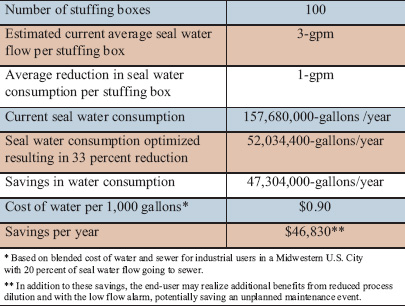Pumps & Systems
October, 2007
Two imperatives for many of today’s industrial plants are to reduce the cost of operations through the enhancement of rotating equipment reliability and enhanced energy efficiency of pumping systems.
One place to look for a significant, yet relatively easy “quick win,” is the seal flush water going to packing, single, and double seals. In many industrial plants water is being used to provide lubrication, cooling and/or as a means to exclude a harmful process fluid from the stuffing box or seal chamber.
The means for providing an external water flush or quench are generally described as API/ISO piping plans 32 (ANSI 7332), 54 (ANSI 7354) or 62 (ANSI 7362).

These plans have certain potential issues that can be opportunities for improving operating costs, namely:
* Higher flow rates than required for optimal packing or seal performance.
* Lower flow rates than required for optimal packing or seal performance.
* Orifices plugging with no readily accessible means to clean them.
* Cumbersome and space consuming piping configurations in order to include basic requirements of an appropriate system, such as pressure and flow control as well as monitoring, check valve and low flow alarm.

A potential solution to address these issues would be a single compact unit that includes all of the functionalities below:
* Allows the end-user to readily optimize seal water pressure and flow to maximize packing and mechanical seal MTBR.
* Enables the end-user to readily monitor the seal water pressure and flow.
* Conveniently and economically incorporates a low flow alarm while still maintaining a minimal piping footprint.
* Saves space.
* Typically will reduce seal water consumption by about 1/3rd while optimizing packing and mechanical seal performance.
* Reduces process dilution.
* Can enhance rotating equipment reliability by alerting plant personal to a low flow condition that could lead to an unplanned maintenance event.
* Easy to maintain with readily accessible cleaning button that does not disturb flow or pressure.

Water quality is an important consideration. Plant water quality can vary significantly from one location to another and affect these units, so it should be monitored. Inspection and maintenance procedures should take water quality into consideration. It also is always best to consult with your seal supplier to ensure optimum cooling flow rates for your system.
The table above is an example of a way to achieve significant operating savings through optimizing seal water flush. The basis is reduction in seal water consumption by an average of 1-gpm per stuffing box served.
The bottom line on how to reduce consumption of seal water going to packing and mechanical seals is to consider replacing your existing seal water flush piping plan with a single unit seal water flush control and monitoring device. You will save operating costs as well as space.
http://www.pump-zone.com/seals/mechanical-seals/how-can-i-reduce-consumption-of-…
